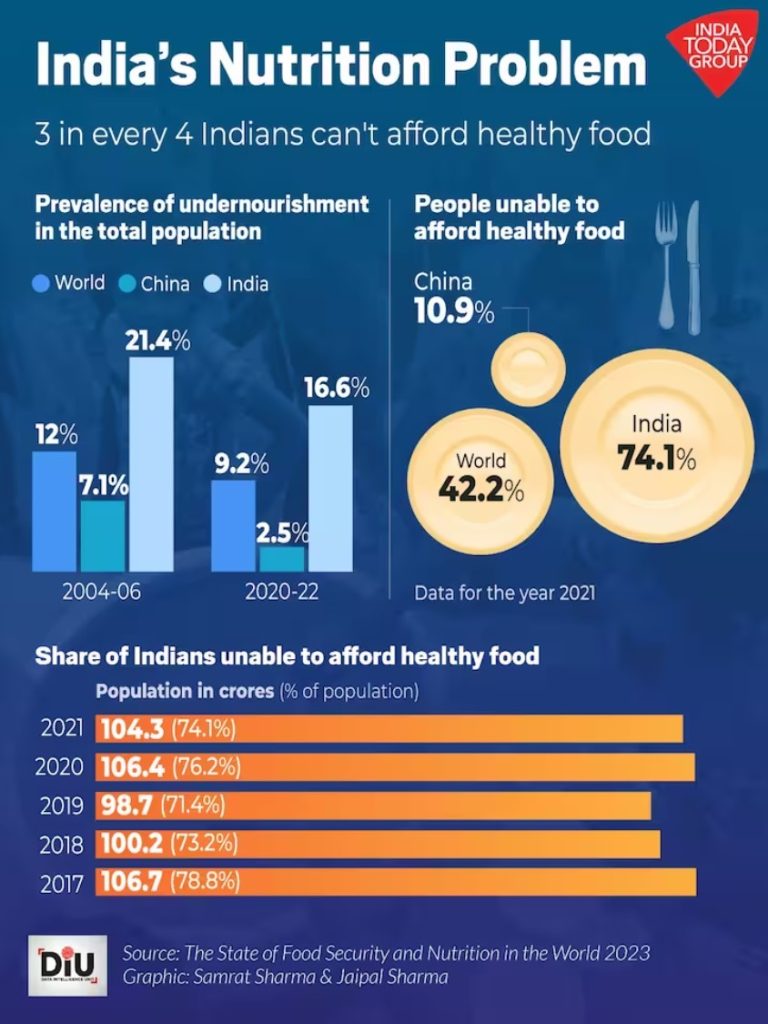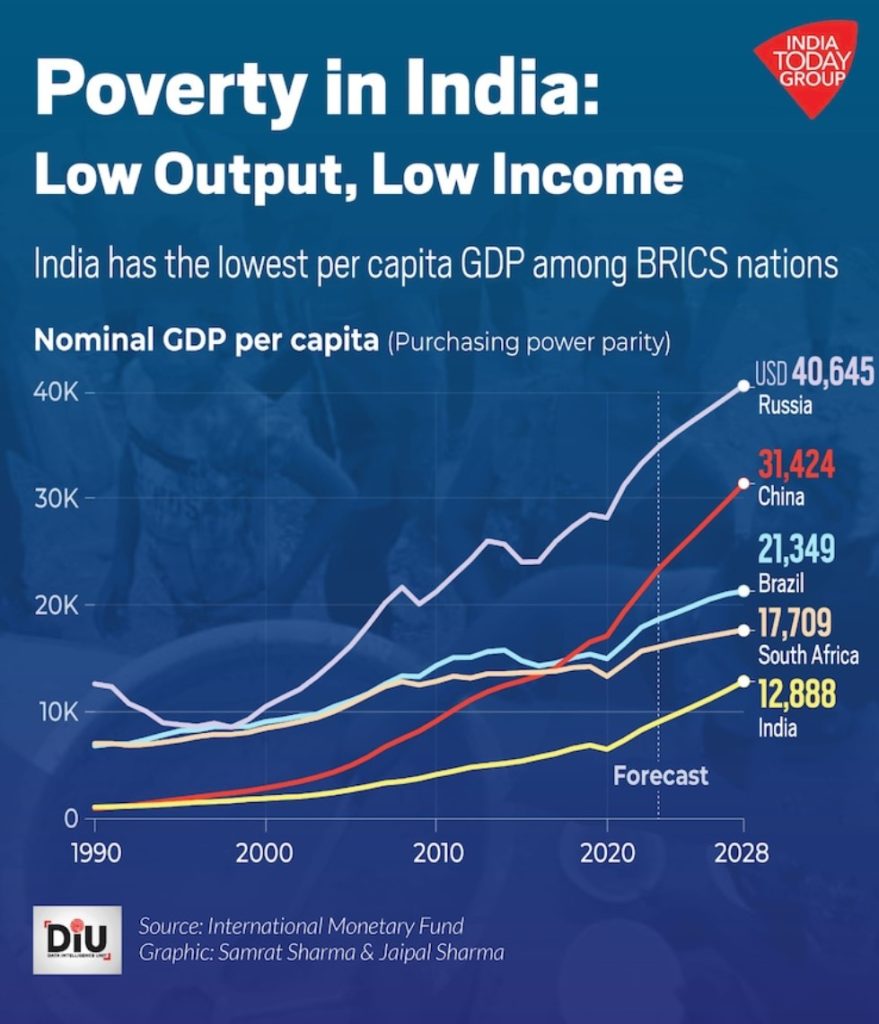CONTENTS
- Counting the ‘Poor’ Having Nutritional Deficiency
- India’s Abolition of Angel Tax: a Major Boost for Startups and Investment
Counting the ‘Poor’ Having Nutritional Deficiency
Context:
The National Sample Survey Office recently published a comprehensive report from the Household Consumption Expenditure Survey (HCES): 2022-23. Alongside the report, the unit-level data on household consumption expenditure (HCE) is accessible to the public.
Relevance:
GS3- Inclusive Growth and issues arising from it.
Mains Question:
Implementing nutritional schemes targeted at the poorest of the poor significantly enhances their nourishment levels and contributes to a healthier life. Discuss. (10 Marks, 150 Words).
About the HCES Data:
- The HCES gathered data on the quantities of various food items consumed by households over specified reference periods and the total value of consumption for different food and non-food items.
- This analysis uses this information to convert the quantities of consumed food items into their total caloric value and compares the estimated per capita daily calorie intake of household members in the lower expenditure classes with the average per capita daily calorie requirement for a healthy life.
Measurement Approach:


- This analysis tackles two primary issues: defining the ‘poor’ and the measurement of nutritional levels.
- In India, various government committees, including the Lakdawala, Tendulkar, and Rangarajan Committees, have defined the poor as those below the ‘poverty line’ (PL).
- The PL is a monetary equivalent based on household monthly per capita consumer expenditure (MPCE) sufficient for purchasing the food and non-food items in the poverty line basket (PLB).
- The Lakdawala Committee based the PL and the PLB, which included both food and non-food items, on calorie norms of 2,400 kcal per capita per day for rural areas and 2,100 kcal per capita per day for urban areas. Conversely, the Tendulkar Committee did not link the PL to a calorie norm.
- The Rangarajan Committee’s PL is based on ‘certain normative levels of adequate nourishment, clothing, house rent, conveyance, and education, along with a behaviorally determined level of other non-food expenses.’
- The methodology of this analysis first calculates the average daily per capita calorie requirement (PCCR) for a healthy life based on the recommended energy requirements for Indians of different age-sex-activity categories, as per the latest (2020) report by the ICMR-National Institute of Nutrition.
- The PCCR (Per Capita Calorie Requirement) is calculated as a weighted average of the calorie needs of individuals in different age, gender, and activity categories, with weights based on the estimated proportions of people in these categories according to the Periodic Labour Force Survey, 2022-23.
- In the next step, individuals are sorted into 20 classes of MPCE (Monthly Per Capita Consumer Expenditure) ranging from the poorest to the richest, each comprising five percent of the population.
- The average per capita daily calorie intake (PCCI) and average MPCE (covering both food and non-food) for each class are derived using data from the HCES 2022-23.
- From this nationwide distribution, the average MPCE on food that aligns with the normative level of the PCCR is determined.
- In simple terms, this average per capita expenditure on food can be seen as the minimum amount a household needs to spend on food items to ensure its members can lead a healthy life.
- This average per capita expenditure on food, along with the average MPCE on non-food items for the poorest five percent, is combined to determine the total MPCE threshold (at average all-India prices) necessary for spending on both food items (ensuring adequate nourishment) and non-food items with minimal expenditure.
- This nationwide total MPCE threshold is adjusted for price differences across States/UTs using general Consumer Price Index numbers to calculate the corresponding State/UT-specific total MPCE thresholds.
- The proportion of ‘poor’ or deprived individuals in each State/UT, specifically for this analysis, is calculated as the percentage of people below these total MPCE thresholds.
- Finally, the national proportion of ‘poor’ or deprived individuals is calculated as the weighted average of the State/UT-wise proportions of deprived people, with weights based on the projected populations of the States/UTs as of March 1, 2023, according to the July 2020 report of the National Commission on Population.
- The analysis involves certain approximations in determining the calorie intake figures at the household level in several cases where the HCES data reports aggregate quantity figures for certain grouped items.
Estimated PCCR:
- The PCCR is estimated at 2,172 kcal for rural India and 2,135 kcal for urban India. At 2022-23 prices, the nationwide threshold total MPCE is ₹2,197 (food: ₹1,569 and non-food: ₹628) for rural India and ₹3,077 (food: ₹2,098 and non-food: ₹979) for urban India.
- The corresponding proportion of ‘poor’ or deprived is estimated at 17.1% for rural areas and 14% for urban areas.
- If the non-food expenditure of the poorest 10% is considered instead of the poorest five percent, the threshold total MPCE increases to ₹2,395 for rural areas and ₹3,416 for urban areas, resulting in a rise in the proportion of deprived individuals to 23.2% for rural India and 19.4% for urban India.
- Regarding nutritional deficiency, the average PCCI of the poorest five percent and the next poorest five percent in rural India is 1,564 kcal and 1,764 kcal, respectively.
- In urban India, it is 1,607 kcal and 1,773 kcal, respectively, which fall significantly short of the PCCR.
Conclusion:
The government has several welfare programs aimed at improving the health conditions of the poor. Implementing nutritional schemes targeted at the poorest of the poor could significantly enhance their nourishment levels and contribute to a healthier life.
India’s Abolition of Angel Tax: a Major Boost for Startups and Investment
Context:
Union Finance Minister Nirmala Sitharaman, in her seventh Budget, has proposed the abolition of the Angel Tax, marking a significant step towards strengthening the Indian startup ecosystem. This tax had been a longstanding contentious issue between startups and the Income Tax Department, serving as a major obstacle to growth and investment.
Relevance:
GS3-
- Employment
- Growth and Development
- IT and Computers
- Mobilization of Resources
Mains Question:
The removal of angel tax, combined with procedural simplifications, promises to create a more dynamic and supportive environment for startups. Analyse. (10 Marks, 150 Words).
About Angel Tax:
- The Angel Tax, which was essentially a tax on capital raised by unlisted companies through the issuance of shares, was introduced under Section 56(2)(viii) of the Income Tax Act, 1961.
- It taxed investments above the fair market value of a company as ‘Income from other sources,’ primarily affecting angel investors.
- The excess realization was considered income and taxed accordingly. Although this provision was intended to curb money laundering, it ended up stifling genuine investments and became a significant hurdle for startups.
Significance of the Removal of this Tax:
Transform the Startup Landscape:
- The removal of this tax, especially if accompanied by procedural simplifications, could indeed transform the startup landscape, fostering a more vibrant and dynamic environment that encourages innovation and entrepreneurship.
- The abolition of this tax removes a major barrier that has long impeded the growth of startups and discouraged investment.
- Startups can now raise capital without the fear of being taxed on perceived excess valuations, which often failed to account for the future growth prospects and potential of these young companies.
- This decision is likely to encourage more investors to back innovative ideas, knowing that their investments will not be subjected to additional tax burdens.
- As a result, startups will have greater access to the funding they need to scale their operations, bring new products and services to market, and contribute to economic growth.
Creation of Jobs:
- This strategic move is anticipated to enhance India’s position as a global hub for innovation and entrepreneurship, ultimately benefiting the economy as a whole.
- This, in turn, will boost economic growth and create jobs. For example, the comprehensive digitalization of taxpayer services and the simplification of the GST tax structure demonstrate the government’s commitment to digitalization, which will benefit tech startups in various fields like education, healthcare, and taxation.
- In recent years, India has been a global leader in creating successful entrepreneurship opportunities.
- The investor community, including high-net-worth individuals (HNIs), foreign funds, venture capitalists, and angel investors, has been optimistic about the growth potential of the Indian startup ecosystem.
- However, the Angel Tax had overshadowed this optimism, causing significant distress among startups and investors alike.
- While government initiatives such as Startup India, Stand-up India, and Digital India have created a favorable environment for startups, the Angel Tax was a major issue.
- The Central Board of Direct Taxes (CBDT) had even unsettled the startup ecosystem by directly deducting income tax under Section 68 from the bank accounts of certain startups on unexplained cash credits.
- The abolition of the Angel Tax, along with the recent notification simplifying compliance procedures, reflects the government’s responsiveness to the concerns of the startup community.
Startups no longer need to obtain a fair market value certificate:
- Startups no longer need to obtain a fair market value certificate from a merchant banker or seek approval from an inter-ministerial board.
- Instead, they can request an angel tax exemption from the Department for Promotion of Industry and Internal Trade (DPIIT) with the necessary supporting documents.
- The CBDT is required to respond to such applications within 45 days, offering startups much-needed clarity and certainty.
- While abolishing the Angel Tax is a significant step forward, its impact will largely depend on how it is implemented and further procedural simplifications.
- The focus should be on creating a regulatory environment that is friendly to startups, encouraging both investment and innovation.
- The government’s emphasis on digital public infrastructure and the digitalization of the economy will also play a vital role in supporting tech startups and fostering a culture of innovation.
Conclusion:
Overall, the abolition of the Angel Tax is a welcome move that promises to remove a significant barrier to startup growth and investment. However, for this initiative to truly be transformative, it must be accompanied by procedural simplifications and a supportive regulatory environment. The government’s continued focus on innovation, digitalization, and economic growth will be crucial in unlocking the full potential of this policy change.



